Thu 17 Mar 2016
Himself discusses the fairies
Posted by PJ under fairies, folklore, video
No Comments
For St. Patrick’s Day, here’s the incomparable Eddie Lenihan telling a tale:
Thu 17 Mar 2016
Posted by PJ under fairies, folklore, video
No Comments
For St. Patrick’s Day, here’s the incomparable Eddie Lenihan telling a tale:
Wed 2 Mar 2016
Posted by PJ under folklore, goddesses, ritual, theater
No Comments

A recent story on National Public Radio told the story of the kabuki festival of Damine, Japan. For over three centuries this small mountain village has had an unbroken yearly tradition of having their children perform to please the mountain gods.
“Legend has it that hundreds of years ago, the mountain village was jeopardized when someone accidentally chopped down one of the shogun’s trees,” says Hina Takeshita, the 12-year-old star of the closing kabuki play [of the festival].
As news spread that the shogun, a feudal commander, was coming to investigate, the villagers prayed to the gods. They promised to perform kabuki every year if the goddess of mercy could make it snow. A rare June blizzard arrived, thwarting the visit by the shogun’s samurai and saving the village from punishment.
“So we’ve been playing kabuki ever since then,” Hina says.
You can read more about Damine’s festival in this article from National Public Radio. It’s mostly about the growing hardship of staging the festival as the village population shrinks because so many people have migrated to the cities. There are only 10 children left between the ages of 6 and 12.
Here’s a video of one of their performances:
Tue 23 Feb 2016
Posted by PJ under caregiving, crime and punishment, folklore, hauntings, los angeles, mysteries, obsession, today's mystery, urban legends
No Comments

I suspect most people’s obsession with the place began with this article from 2009 by Bob Pool, writing for the Los Angeles Times. That’s certainly when mine began.
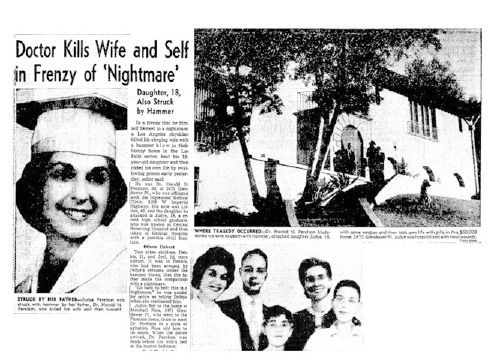
A horrible tragedy, but one that would probably have faded with time because, unfortunately, this is a scenario that has been encountered in the news many times. But here’s where the obsession kicks in. You see, the house was bought at a probate sale in 1960 by a couple named Emily and Julian Enriquez. It’s said (though I no longer remember where I read this) that the family moved in with their son, Rudy, for a very brief time, and moved back out again suddenly, leaving all the Perelson furniture and possessions behind—and, it’s said, some of their own. Since then, for more than fifty years, the mansion has sat abandoned. The Enriquez family used it over the years to store things, but to this day you can peak into its windows and see covered mid-century modern furniture, 1950s-era newspapers and magazines, Christmas presents, board games, an ancient TV, and other bric-a-brac of life back then.

Of course, stories abound of the place being haunted and having a weird feel. Even the Times article couldn’t resist a spooky bit at the end, telling the story of a neighbor whose curiosity got the better of her. She briefly pushed open the mansion’s backdoor to snoop, but heard the burglar alarm and beat a hasty retreat. Her hand started to throb and a ugly red vein traveled up her arm. A visit to the ER confirmed that her brief foray into Breaking and Entering had left her with the bite of a black widow spider. Two nights later, the burglar alarm on her own backdoor kept going off, but when she looked, no one was there. “It was like the ghost was following us,†she said.
Rudy Enriquez himself claims, “The only spooky thing there is me. Tell people to say their prayers every morning and evening and they’ll be OK.†Which, I have to say, does nothing to alleviate the spookiness.
Since the publication of the Times article, looky loos have driven the neighbors crazy trespassing on the property and breaking into the mansion. Those same neighbors originally encouraged the article because prostitutes and other unsavory types had started breaking in to crash. That doesn’t happen anymore since the owner put in an alarm system, but the unexpected consequences of the neighborhood stirring up the public’s curiosity and obsession is clearly a case of be careful what you wish for.
If you want to know the depth of obsession out there, visit the Find-a-Death thread on it. But I warn you, if you visit that site and read through the entire thread, be prepared to spend hours.
I also fell into the rabbit hole of obsession about this place right after I read the Times article. When I saw that Dr. Harold Perelson had a medical practice in Inglewood, near to my own home, something deep and strange clicked inside me.
My backbrain insisted this information had personal significance, that I needed to find out where the practice had been located. I immediately jumped to the conclusion that the doctor had once had an office in the old Inglewood medical building where my mother’s kidney specialist practiced. The building certainly seemed like it could date back to 1959. Who knew? Maybe his practice had been in the same office the nephrologists now occupied!
I became obsessed with finding out. I scoured the internet for online collections of street maps and phone books. There were many, but nothing online for Inglewood of that time period. I knew I would have to physically go to one of the libraries containing these holdings and look up the information, but my life was so frantic by then with being a full time caregiver and working full time that, well, time was the one thing I didn’t have. I couldn’t even take an afternoon off to go to a library.
I’d let it go for a while, but the obsession still gripped me. Every now and then, I’d revisit the online archives to see if the phone books, et al., had been uploaded, and I’d search out more articles and information on the case, finding the most obscure things to download to my mystery folder. I’d visit Find-a-Death, too, to see what they’d come up with.
Then I stopped being a caregiver through the inevitable way those things happen.
I didn’t immediately think of the Los Feliz Murder Mansion, but a month later while clearing out old files from my computer, I came across the folder where I kept my mystery stories. Los Feliz, being the most obsessional of them all, jumped out at me. Out of idle (okay, not so idle) curiosity I decided to head back to Google. My old “friends†at Find-a-Death (I’m not a member, although I have taken Scott Michaels’ tour) popped up so I visited the site. I went to the most recent page to work my way backward for the “newest†posts about this old mystery. People still post about it, the mansion is still abandoned, still owned by Rudy Enriquez, still a burden to its neighbors, still spooky as hell.
Several pages back from the last entry, a post from November 2014 gave the address of Dr. Perelson’s medical practice. The poster believed it was now a family dental clinic. I was thrilled and disappointed at the same time. It wasn’t the address for the building in which my mother’s doctors practiced. What the heck could my backbrain have been thinking? Clearly, not for the first time, I’d fallen prey to flights of morbid imagination.
But the address—3108 W. Imperial Highway—did have something of a personal connection, after all. You see, I’d driven along portions of Imperial Highway 3-4 (or more) times a week for the last five years. My mother’s dialysis clinic was on Imperial Highway. I didn’t think I was emotionally ready to make that drive again, so I looked up the address on Google street view. The building housing the family dental clinic was gone. That area has seen a vast revival, and a new mall exists where the office once stood. That’s why Google maps showed the address in the middle of an intersection. It doesn’t exist anymore.
But I knew that intersection, knew it well. I sat staring at it in shock a long, long time. Because, you see, I’d driven through it 3-4 (or more) times a week for the last five years. It was located approximately a half block from my mother’s dialysis center.
Click here to see pictures of that intersection.
Is my obsession gone? Once I’d made the personal connection it did fade. But old obsessions are hard to kill and I feel it grabbling for my attention even now. I think sometimes we prefer our mysteries unsolved so we can reside forever in the sweet tantalization of speculation. Certainly, I believe the scores of people doggedly pursuing this story will be disappointed once Rudy dies and the mansion invariably gets sold off and torn down.
But you never know. Maybe new mysteries will spring from its footprints. Ghosts are as hard to get rid of as obsessions and not always banished by the rational expediency of tear-down. For what are ghosts if not the stubborn obsessions of human souls unready and unbelieving in death, unable to give up their unfinished business, playing and replaying their moments of personal nightmare?
Rudy has passed away. The Murder Mansion is for sale: http://www.australianetworknews.com/want-to-stay-with-ghosts-murder-house-haunted-by-ghosts-for-sale-in-la/
Thu 18 Feb 2016
Posted by PJ under crone, folklore, women
No Comments
 z
zHere’s an interesting article from National Public Radio: Why Are Old Women Often the Face of Evil in Fairy Tales and Folklore?
Mon 8 Feb 2016
Posted by PJ under brain, fairies, folklore, mind, perception, vision
No Comments
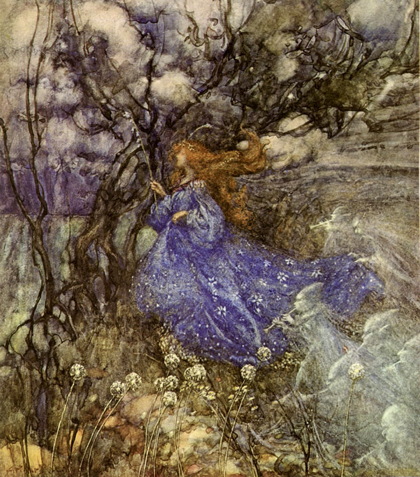
You don’t have to be crazy to see things that 1) aren’t really there; 2) other people don’t see; 3) are glimpses of an alternate reality; 4) all of the above and maybe a whole lot more.
I was reading an interesting article from DarkLore, Vol. 8, edited by Greg Taylor: “Dreaming While Awake: A History of Sane Hallucinations†by Mike Jay. You can read the entire article here. In it he speaks of a 90-year-old gentleman, Charles Lullin,
whose sight had been progressively failing since a cataract operation five years before [in February of 1758]…[who] began to see considerably more than he had become accustomed to. For the next several months he was visited in his apartment by a silent procession of figures, invisible to everyone but him: young men in magnificent cloaks, perfectly coiffured ladies carrying boxes on their heads, girls dancing in silks and ribbons.
His grandson, Charles Bonnet, wrote about these visions and those of others with failing sight. It became known as Charles Bonnet Syndrome.
My mother was just shy of 94 when she passed. I thank all the gods that she retained her mind and clarity, her self, until the last three weeks of her life. When she was 91, however, she had a stroke. We were “lucky†because neither her motor skills nor her speech was affected, although her balance permanently disappeared from that point. She couldn’t stand without a walker, not from muscle weakness but because she would tumble over backward without one. For a woman of her vigorous physicality and drive it was quite a frustration. However, the worst of it was that the stroke affected her eyesight: she had alternating bands of vision and blindness in each eye. The brain, confused by the input it received, often took the jumbled bits and assembled them into something that made sense to it.
My mom at first thought these visions were fact until I explained to her that I wasn’t seeing the same thing. She got so she’d say things like, “There probably isn’t a soldier in a red uniform standing in the corner, is there?†And I would allow as how I didn’t see one. I remember one time discussing with her the weird perception of waking up and not knowing where you are, thinking maybe you’re in some place you lived in two or three moves ago. Mom said that sensation had gone a step further for her: she’d wake and although she knew where everything was and everything looked the same, that the neighborhood seemed familiar, she felt as if the house wasn’t where it was supposed to be. Somehow it had moved, she knew not where. I told her, “Maybe we’ve slipped into an alternate reality and you’re the only one who realizes it.†She laughed. “Maybe so.â€
She’d wake up and lie in bed watching a parade of showgirls in full Vegas regalia promenade through her bedroom, up a staircase that didn’t exist, and through a nonexistent second story door. These things probably did not actually exist, but Mike Jay wonders, and so do I, what the true nature of hallucinations are, if no visual impairment exists, if one is not taking strong narcotics, if one is a perfectly rational human being. A significant minority of sane people do see and hear (and smell) things, as many as ten percent of the population. As Oliver Sacks says, “Seeing Things? Hearing Things? Many of Us Do†(New York Times, November 3, 2012).
Mike Jay speaks of “Lilliput sight,†where people see things much smaller than they are. And of parades of tiny people marching to and fro about the room, often ignoring or disdainful of attempts by perceivers to communicate with them. A friend of mine who was a paranormal researcher told of a highly proficient office manager and “nice lady,†who told him that every night for a month, little trooping fairies climbed up her bedspread, marched across the bed, then climbed down the other side and disappeared under the bed. She was too afraid to get up and look under the bed. And as suddenly as the phenomena started, it stopped. A temporary brain fugue? Maybe. But it sounds all too familiar, doesn’t it? Like many of the fairy stories of old.
But, although many of the percipients of odd things in such books as Lady Gregory’s Visions and Beliefs in the West of Ireland or W. Y. Evan-Wentz’s The Fairy Faith in Celtic Countries were elders, a significant number were not. Or going blind. Or sots. Or craaaazy. The brain undoubtedly generates chimera, trying to make sense of bits of disjointed experience. These things may exist completely inside a rational mind, conjured up by misfiring synapses, odd perception, or neurological fugue.
Or maybe they aren’t. Maybe the doors to perception do open at random intervals and people catch a glimpse of numinous tides, of What Could Be, or What Is in some universe Over There.
Sat 23 Jan 2016
Posted by PJ under 9/11, archetypes, conscious and subconscious, folklore, photography, tarot
No Comments
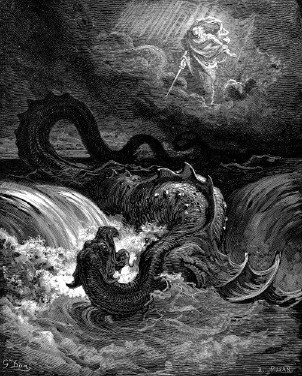
“Although we human beings have our own personal life, we are yet in large measure the representatives, the victims and promoters of a collective spirit whose years are counted in centuries. We can well think all our lives long that we are following our own noses, and may never discover that we are, for the most part, supernumeraries on the stage of the world theater. There are factors which, although we do not know them, nevertheless influence our lives, and more so if they are unconscious.â€
—Carl Jung, Memories, Dreams, Reflections, tr. Richard and Clara Winston
There are two images for this post, besides the one above, both behind a cut at the end of this post. One is called the falling man, a photograph by Richard Drew, the other is called the hanged man. I’ve put them behind a cut because even now some people don’t like looking at images from 9/11, and this image caused some controversy when first published. There’s nothing gory about it, but it does represent the last moments of a man’s life. Some feel that’s a private moment and should never be seen. I don’t discount their feelings, but I also believe it’s something more: a testament of the horrors of that day, of terrible decisions forced on ordinary people, of their courage and grace in making those choices, no matter how desperate.
All I know is that the first time I saw the image of the falling man it resonated inside me like a struck bell—beautiful, horrible, incomprehensible. Yet deeply known. In the amazing and moving documentary, 9/11: The Falling Man, made about this picture, it’s revealed that the editors of The New York Times had a series of pictures in this sequence to choose from, but found this one most compelling. I don’t think that’s a coincidence.
Of course, there’s a personal horror of recognition here. One morning you go to work and something unthinkable happens to rip everything away. This picture represents the ultimate “there but for the grace of God go I” moment. But that’s not what my deeper cord of recognition was about. This man’s death was not a symbol, but there was a potent symbol in that sky. It took me a couple of days to understand it. An image from tarot came to me: the hanged man. Not in the sense of portents in the sky or any other such bull, not to minimize the power of the falling man by reducing the image to a formula. The image is its ownself, vast and powerful, but there’s also this other thing falling beside it: archetypes working themselves through the real world and through our psyches.
This phrase about the hanging man card from aeclectic.net in particular struck me: “It is as if he’s hanging between the mundane world and the spiritual world, able to see both. It is a dazzling moment, dreamlike yet crystal clear. Connections he never understood before are made, mysteries are revealed.”
Not him, you understand, but us…suspended between life and death, the sacrifice to gain knowledge, a time of trial or meditation, the moment of clarity, of not being able to see things the same again. It’s not just this man’s life, and the ending of it, but that moment of suspension and terrible clarity for the United States and the world.
That subconscious strata of images and ideas is always at play inside each of us. I’m not in any way saying those archetypes are the only reason we respond so powerfully to the image of the falling man, but I do believe they are part of the mix. Whether or not you have ever seen a tarot deck, or this particular tarot deck, this image doesn’t exist in a vacuum. It appeared in the tarot because it was part of our culture’s archetypal and intuitive heritage. Perhaps it’s an image that would resonate only in Western culture—I don’t know enough to say otherwise—but it is part of the unconscious lives of everyone who has ever lived in the West for any length of time.
And what does it ultimately say about 9/11? Maybe that archetypes are cultural snapshots—or roadmaps—of the great moments in human existence, both specific and nonspecific, grandly sweeping and intimately personal.
Each of us is composed of both conscious and unconscious associations. We need to examine ourselves closely before leaping on any bandwagon or cause or demagoguery, committing ourselves to actions and movements that rob us of our individual and essential humanity and turn us into impulsive mobs, spurred to commit atrocities in the name of some deep, unthinking leviathan swimming just beneath the waters of consciousness. (more…)
Wed 13 Jan 2016
Posted by PJ under art, dreams and dreamtime, folklore, indians, legends, memories, wolves
[4] Comments
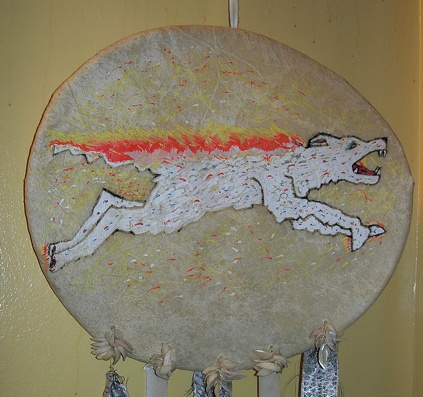
Some years ago, when I was still doing art inspired by American Indian sprituality, I had a powerful dream. In this dream, I was gazing into a campfire out in the woods. An enormous grey wolf emerged from the fire, leaping over my head and knocking me flat on my back, his fur trailing sparks of fire that left my eyes dazzled. He ran off and disappeared into the darkness of the forest.
When I woke, I thought perhaps this was a power dream sent to me by the wolf spirit. My teacher had encouraged me to take such dreams seriously and to use them in the artwork. As it happened, I was in the process of making a medicine shield, an object inspired by personal visions, or vision quests, and used by various tribes to protect them spiritually. I figured the dream had sent me the image I needed for it.
When I presented the finished shield to my teacher, she was amazed. “What inspired you to use this image?†she asked.
I told her about the dream.
“You already knew about the firewolf, then?â€
“Firewolf? No, I’ve never heard of that.â€
She went on to explain that in the traditions of some tribes, fire is considered a wolf and must be treated with respect. You must remember to thank the firewolf for its help in keeping you warm and cooking your food, for the positive benefits it brings, or it might turn on you.
“It’s really significant,†she said, “that you had that dream and had never heard of the firewolf before.â€
I thought so, too, and was amazed. I wondered briefly if it might be a case of cryptomnesia, where one is exposed to an idea but doesn’t recall the exposure. But whatever it was, I was thrilled.
I thought I’d write about it for the folklore blog. I duly set about looking up the firewolf legends on the internet in order to provide some references. And therein lies the problem. I found pagans named Firewolf, fictional stories about fire wolves, games featuring fire wolves, so clearly the concept is in the zeitgeist. But I found almost nothing about American Indian traditions concerning fire and wolves. According to Native American Mythology A to Z by Facts on File, Incorporated, the Ute Indians believed Wolf brought fire to mankind:
Tales frequently involve the theft of fire from the being that possessed it. Often the bringer of fire was an animal or a bird, such as Beaver (Nez Perce), Coyote (many traditions), Deer (Nootka), Fox (Jicarilla Apache), Muskrat (Anishinabe), Turkey (Cherokee), or Wolf (Ute). Grandmother Spider (Spider Woman) stole fire for the Choctaw. In one Cherokee tale, a water spider was responsible for the gift of fire.
So, I don’t know what tradition my teacher was referring to. Indian mythology is not a monolith—each tribe has their own set of stories and beliefs. Sometimes there’s overlap, but each tradition is unique, and there are many, many stories out there. I just have no idea which one she meant.
And the cryptomnesia idea is playing through my mind again, once I saw that the Utes believed Wolf brought the first fire. My mother, you see, grew up on the Ute reservation. It’s entirely possible I heard something along the way.
Which does nothing to diminish the vividness and power of that dream. That remains a gift of the unconscious realm, the realm where all things are possible, where mysteries are far more important than answers.
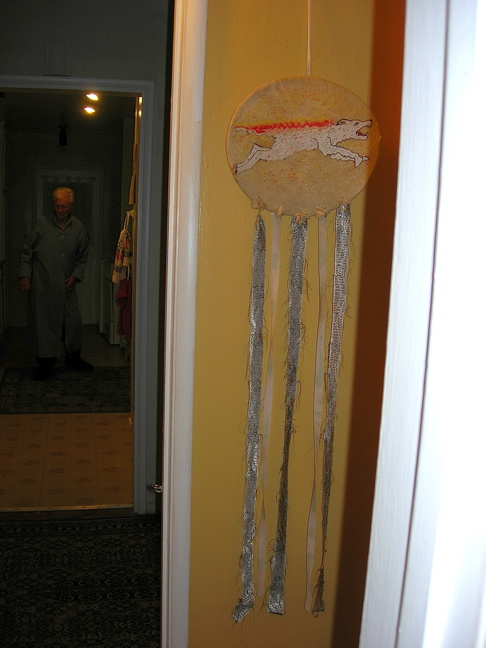
Thu 17 Dec 2015
Posted by PJ under fairies, folklore, video
No Comments
This is CGI, but one of the best of its kind I’ve seen. The payoff is definitely worth the watching.
Sun 6 Dec 2015
Posted by PJ under belief, folklore, gods, healing, pilgrimage
No Comments

I’ve long been fascinated by places of pilgrimage, about the spirit of a place that inspires ordinary people to leave the familiar and embark upon an arduous quest. One such place is El Santuario de Chimayo in New Mexico. I’ve wanted to visit it for a long time. I haven’t made it there yet, but a friend recently made the trip and brought me back some holy dirt.
You see, this tiny church, located between Taos and Santa Fe, has long had a reputation for its miraculous healing dirt. Its walls are lined with crutches, Lourdes-style, and letters from people who claim to have used the dirt dug out of its sacristy to cure their ailments. Most rub it on affected areas and say prayers, though some are said to ingest it. The church discourages this practice and remains neutral on the question of healing. Yet still the pilgrims come. Unlike many other places of pilgrimage, El Santuario hasn’t replaced its sweet, simple church with a grand cathedral, which is one of the reasons I’ve wanted to go there. Tens of thousands of people each year make the trek, some walking during Holy Week from Taos or Santa Fe or even Albuquerque as an act of penitence and devotion, payback for answered prayers, or seeking blessings. Some are said to make part of the walk on their knees in a more extreme act of devotion.
The dirt comes from a tiny well, call el pocito, and the thing is…it’s got to be refilled periodically from the nearby hills of the Sangre de Cristo Mountains because so many people come to scoop it out of the well: an estimated 25 to 30 tons a year. The pilgrims know this—the church doesn’t seek to hide it—and believe in the dirt’s power anyway.
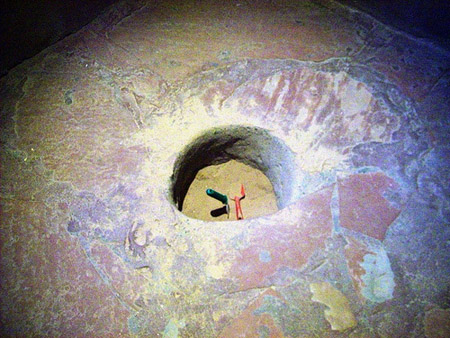
My friend, knowing my interest, brought a plastic baggie of it to me. I mean no disrespect by calling it holy dirt—the church itself refers to it that way on its website, where you can buy folk art and receptacles to hold it. The dirt itself is very fine grain and reddish-brown, containing tiny pebbles, and resembles nothing so much as brownie mix with chopped walnuts. I had to resist the urge to dab my finger and take a taste. I love folk art, and I admit to buying some of their chachkies, some to hold my dirt, some just because I liked them.
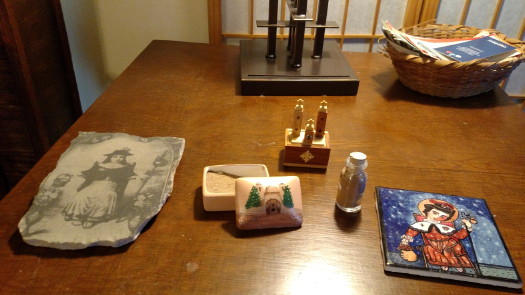
I’ve never witnessed the pilgrimage to Chimayo, nor any of the acts of devotion associated with it. But I did witness such acts at the Basilica of La Virgen de Guadalupe in Mexico City. I saw penitents crawl across the cobbled square in front of the church on their knees, heading towards the steps, up the aisle and to the altar. I saw a man and a woman. They were both older, maybe in their fifties or sixties. The woman wore a dress and kneeled on a cloth, pulling it forward with each “step” she took on her knees while family members hovered around with anxious faces. The man had only his pants between him and the cobbles. Both the man and the woman wore looks of pain—but determination. They would make this knee-walk of devotion.
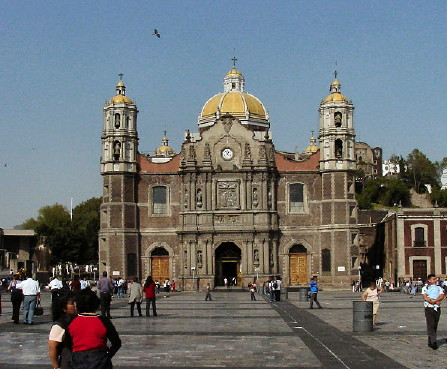
I was 18 at the time and remember thinking they were crazy, that I would never make such a pledge to a deity, certainly never carry out such an act of devotion. I’m older now, and although I still would not make such a pledge (my knees would never hold up, for one thing), I no longer view their devotion as an act of insanity. These were ordinary people, maybe long time devotees, maybe touched for the first time by the awful and wonderful hand of deity. They made a sincere promise to that holy being and were trying with all their hearts—and their knees—to be faithful to that promise. How can I mock such faithfulness, such sincerity? I’m old enough now to know that I can’t mock them without doing damage to my own soul, my own seeking after truth.
And so it is with all pilgrimages, whether I share the belief of the pilgrims or not. I must respect their sincerity and their peaceful attempts to fulfill their promises to something beyond themselves.
Tue 1 Dec 2015
Posted by PJ under belief, fairies, folklore, video
No Comments
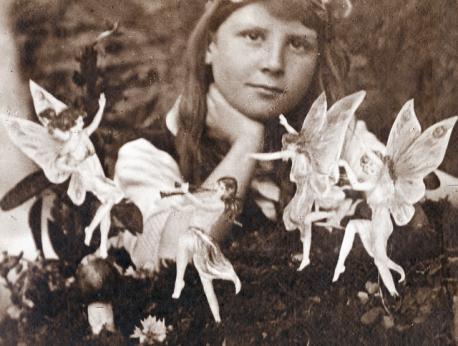
Is there anyone who is a fan of folklore that hasn’t heard of the Cottingley Fairies, for good or ill? There may be a few, I suppose. I’ll give a brief explanation, by way of introducing a very charming film taken from The BBC Roadshow, featuring Frances Griffiths’s daughter and granddaughter.
Basically, two girls named Frances Griffith and Elsie Wright came home one day in 1917 and told their parents Frances had seen fairies by the brook near their village of Cottingley in Yorkshire. Their parents mocked them, which made them mad, so they set about creating photographic proof. They were so determined to come up with this proof that they cut out pictures of fairies from Edwardian books, mounted them on cardboard, and artfully arranged them in the foliage near the brook so they could interact with them. Everyone was amazed. The local theosophists got ahold of the story and ran with it, then the spiritualists, then (and this is what really condemned the girls to a life of lying) the great spiritualist himself, Sir Arthur Conan Doyle, who went so far as to write a book on the subject.
Do I believe in fairies?
Certainly not in cardboard cut out ones. A modern eye isn’t as easily fooled, I don’t think, as Edwardians. (But that could just be early 21st century hubris talking.) We look at these photos and think, “How could anyone be fooled by them?†But people wanted to believe, and in that time when photography was new, many accepted that the camera could not lie—and believed.
Do I believe Frances saw fairies that first day and that childish righteous indignation at being mocked for the truth led her and Elsie to a twisted path of lies?
I believe anything is possible, especially lies hiding a truth, and truths hiding a lie. I believe in the will to believe and the will to persuade. I believe that things unseen are not so easily reproduced upon command and the temptation to give nature a helping hand is sometimes overwhelming. I believe that is almost as tricksy an answer as the Cottingley Fairies themselves, who are often obstreperous and contrary creatures.
And so, the film. I love the little girl in pink standing next to the “expert appraiser.†Her expressions and body language are priceless, swinging between boredom and interest. A child of a different time than Frances and Elsie, to be sure, but no less fascinated.